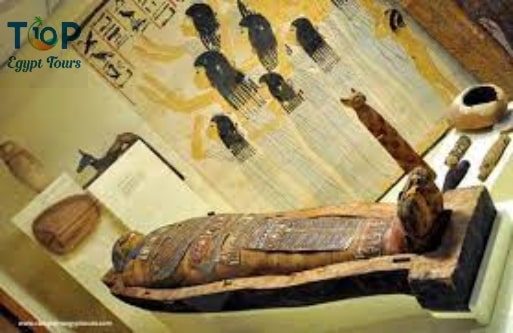Welcome to the heart of ancient civilization, where the mystique of Egypt unravels in every corner. The word mummification is derived from the word mummy, and some still mistakenly believe that it is derived from an Arabic word, considering that mummy is a pure Arabic word, but it is derived from Persian origin, which means black because bodies turn black after being mummified.
The Importance of mummification in ancient Egypt:
– Life after death formed the core belief of the ancient Egyptians. They wanted immortality and sought to achieve it with a healthy body that the soul could recognize and reside again in eternal life, and mummification was their means of doing so.
– The process of mummification was closely tied to the religious beliefs associated with the journey to the afterlife. It was believed that the deceased would undergo judgment in the Hall of Ma’at, where their heart would be weighed against the feather of truth.
The Mummification Process:
– Before the actual mummy process began, the body was washed with water from the Nile River to purify it.
– Removing internal body organs that are susceptible to decomposition, such as the brain. And removing all organs in the abdominal cavity except the heart, as they believed that the heart is the center of a person’s being. The next step involves removing all moisture from the body by covering it with natron, a type of salt that acts like a preservative and desiccant. The final step is to wrap the body in approximately 100 meters of glue-coated linen.
The mummified body, along with funerary tools and other items, was placed in a tomb.
The use of modern technology to study mummies and their preservation techniques:
Computed tomography (CT):
Application: CT is widely used to create detailed cross-sectional images of mummies without the need for physical dissection.
Benefits: This non-invasive technique allows researchers to examine the internal structures of mummies, including bones, tissues and any artifacts that may be present.
Magnetic resonance imaging (MRI):
Application: MRI is used to create detailed images of soft tissues, providing insight into the mummy’s anatomy and potential evidence of disease or injury.
Benefits: MRI is particularly useful for studying well-preserved soft tissues, such as muscles and internal organs, without the need for surgical procedures.
3D imaging and printing:
Application: High-resolution 3D imaging techniques, such as laser scanning and photogrammetry, are used to create digital models of mummies.
Benefits: These models allow researchers to visualize mummies in three dimensions, enabling detailed analysis and even the creation of exact copies through 3D printing.
Here are some key sites related to mummification in Egypt:
1. The Egyptian Museum (Cairo): The Egyptian Museum in Cairo is home to an extensive collection of ancient Egyptian artifacts, including mummies and items related to the mummification process.
2. The Museum of Egyptian Antiquities (Luxor): Located on the east bank of the Nile in Luxor, this museum focuses on the history of ancient Thebes (modern-day Luxor). It houses a collection of mummies, statues, and other artifacts from the region.
3. Luxor Museum: This museum in Luxor houses a diverse collection of artifacts, including items related to mummification and burial practices. It provides additional insight into the history and culture of ancient Egypt.
4. Mummification Museum (Luxor): This museum is dedicated specifically to the process of mummification. It explains the various stages of mummification and showcases tools and materials used in the process. Visitors can learn about the religious and cultural significance of mummification in ancient Egypt.
5. Tutankhamun’s Tomb (Theban Necropolis): While not a museum, the discovery of Tutankhamun’s tomb by Howard Carter in 1922 was one of the most significant archaeological finds of the 20th century. The treasures found in the tomb, including the famous golden mask, are now on display in the Egyptian Museum in Cairo.
Finally, when tourists visit Egypt, they must visit the mummies to witness the genius of the ancient Egyptian in preserving the bodies of the dead for thousands of years.



Comment (0)